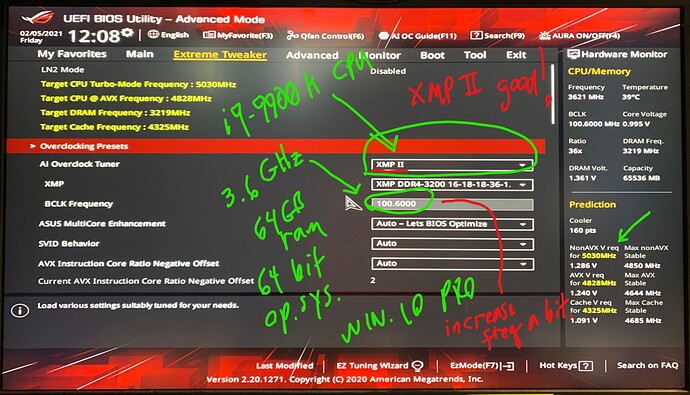Hi Simmers,
I know that some of you are frustrated because of CTD’s, especially when they seem to be tied to overclocking.
Well, I did some experimenting, and this is what I found: The XMP II setting in bios works very well! The sim is now smoother, and I get a higher FPS, generally, in any given scenario.
Oh, I also increased the BCLK frequency a bit, which gave a little more “juice”.
I suggest you hit “F5” first, in bios, to go to default settings before you go to the XMP II setting…
Let me know what happens!
Try it out!
be aware that XMP II is the ‘high risc’ XMP setting !
Still XMP is out of JEDEC Specification and the “big CTD” thread is full of reports where users have CTD because they use XMP mode.
Thus, be very carefully if you use XMP II profile.
I feel that the memory should be able to run at the advertised (XMP) speeds if;
- the memory is on the motherboard QVL list
- the motherboard VRM is good
- PSU is of good quality
- no hardware issues
If the RAM doesn’t run at the advertised XMP profile that’s cause for an RMA.
So no, you don’t need to be very careful with enabling XMP, you just need to be careful selecting the correct components that work well together.
1 Like
XMP Profile II is here meant.. But might be I mixed it up 
EDIT: might be good thing that @RarefiedDrop499 possible can share it’s RAM profiles. Possible use CPU-Z and make a screenshot from SPD tab.
At this moment , I just got a little unsure about XMP I vs II 
The XMP profiles are stored on the RAM itself. So if you pick up faster RAM, the new XMP profiles will be read from the RAM itself, and you’ll get the new XMP profiles that are included with your RAM.
Only thing you have to do is to doublecheck the speed/timings from the sticker on your RAM sticks or packaging and select the correct one from the BIOS (normally XMP2 is the fastest profile it can run, and XMP1 a slower profile, but this might differ for different manufacturers). Main takeaway is that the RAM is tested and validated to run at the XMP profiles (without outside interference, like for example a CPU overclock).
Here’s a short article on the matter
exactly this I meant… I had in my brain that XMP II is the “high risc” XMP Profile.. But as you said, in meanwhile I seen that manufacturers made it in different ways.
But only as this reason I told “be carefull with XMP 2 Profile”… I had better should writen: start with the slowest XMP profile.
PS: but independ of that.. XMP is allways out of JEDEC and kind of overcloacking. The fact that manufactors test before “somewhat”, doesnt change that 
EDIT:
I also seen now, that it is the “AI overcloack profile” from ASUS BIOS, not the directly RAM XMP Profile 

XMP I : "…load the DIMM’s default XMP memory timings ( CL,TRCD,TRP,TRAS ) with BCLK freq and other memory parameters optimized by Asus.
XMP II : "…load then DIMM’s complete default XMP profile
So,.. what ever “optimized by Asus” means…
I read a bit in forums and it seems, these XMP II is in case ASUS more safe.
No.. they don’t test it “somewhat”, they test it extensively (at least, the reputable brands do), and select / bin components based on the spec they want to reach (that’s why faster memory with tighter timings is more expensive).
What Is Intel® Extreme Memory Profile (Intel® XMP)?
Intel® Extreme Memory Profile (Intel® XMP) lets you overclock RAM and compatible DDR3/DDR4 memory to enhance the gaming features built into PCs with Intel® Core™ processor. Get that extra edge you need to dominate.
Also see “certification”…
( the most RAM are XMP Ready …
- XMP Ready - SPD contain uncertain, but stable, profiles
- XMP Certified - SPD profile that have passed supplier tests for the CPU and motherboard.
)
and also interessting:
